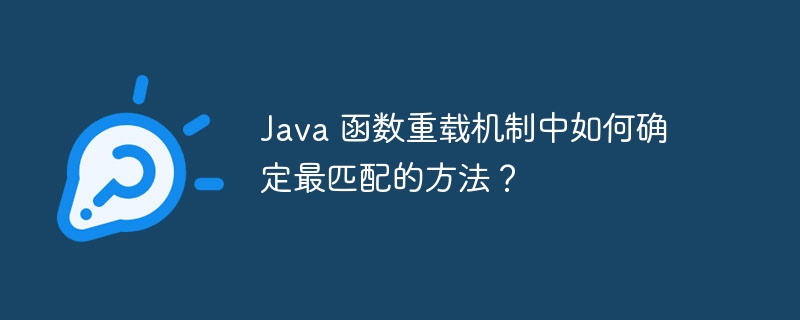 Java
Java
 javaTutorial
javaTutorial
 How to determine the most matching method in Java function overloading mechanism?
How to determine the most matching method in Java function overloading mechanism?
How to determine the most matching method in Java function overloading mechanism?
Apr 26, 2024 am 09:06 AMJava function overload matching rules are: Exact match: Parameter type and number exactly match variable parameters: Variable parameter method matches any number or type of parameters Packaging type and original type conversion: Basic type and packaging type can be mutually exclusive Conversion autoboxing/unboxing: base type values and wrapped type objects can be automatically converted to derived class types: derived class objects can match base class type parameters

Java Matching rules for the function overloading mechanism
Function overloading allows the creation of multiple methods with the same name but different parameter types in the same class. When an overloaded method is called, the JVM determines the best matching method to call based on the argument list.
Determination rules for the best match
- Exact Match: If there is any parameter list of a method that is different from the call If the type and number of parameters match exactly, the method is the best matching method.
1 2 3 4 5 6 7 8 9 |
|
Calling method(1) will match method(int a).
- Conform to variable parameters (Varargs): If a method is declared as a variable parameter, the method can be used with any number or type (including primitive types and objects) Parameters match. Variadic methods must be declared as the last method.
1 2 3 4 5 6 7 8 9 |
|
Calling method(1) or method(1, 2, "Hello") will match method(Object... args ).
- Conversion between wrapped types and primitive types: Wrapping types of basic types (such as
Integer) and corresponding primitive types (such asint) can be converted to each other. If there is a method that matches a raw type parameter but is called with a wrapped type parameter, or vice versa, the method can still be considered a match.
1 2 3 4 5 6 7 8 9 |
|
Calling method(1) or method(new Integer(1)) can match these two methods.
- Autoboxing and unboxing: When a basic type value is passed to a wrapper type parameter, it will be automatically boxed into a wrapper type object. When a wrapped type object is passed to a basic type parameter, it is automatically unboxed into a basic type value.
1 2 3 4 5 6 7 8 9 |
|
Calling method(1) or method(Integer.valueOf(1)) can match these two methods.
- Derived class type: When calling a parameter that uses a derived class object, the parameter can also match the parameter of its base class type.
1 2 3 4 5 6 7 8 9 10 11 |
|
Calling makeSound(new Dog()) will also match the makeSound(Animal a) method.
Practical case
Suppose there is a Shape class, which has the following methods:
1 2 3 4 5 6 7 8 9 10 11 12 13 |
|
When calling Shape shape = new Shape(); shape.draw(5);, the JVM will determine that the most matching method is draw(int size). This is because the size parameter was provided in the call but not the fill parameter, so draw(int size, boolean fill) is not an exact match.
The above is the detailed content of How to determine the most matching method in Java function overloading mechanism?. For more information, please follow other related articles on the PHP Chinese website!

Hot Article

Hot tools Tags

Hot Article

Hot Article Tags

Notepad++7.3.1
Easy-to-use and free code editor

SublimeText3 Chinese version
Chinese version, very easy to use

Zend Studio 13.0.1
Powerful PHP integrated development environment

Dreamweaver CS6
Visual web development tools

SublimeText3 Mac version
God-level code editing software (SublimeText3)

Hot Topics
 Break or return from Java 8 stream forEach?
Feb 07, 2025 pm 12:09 PM
Break or return from Java 8 stream forEach?
Feb 07, 2025 pm 12:09 PM
Break or return from Java 8 stream forEach?












